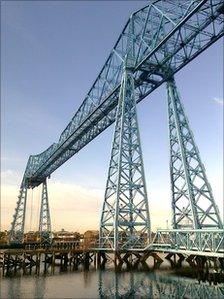Middlesbrough Transporter Bridge celebrates centenary
- Published

The Transporter Bridge is celebrating its 100th birthday
In recent years the numbers of people using the Transporter Bridge has seen a significant increase.
Motorists, it seems, are opting to use 100-year-old engineering rather than take the often jammed Tees flyover.
The bridge, which turns 100 on 17 October, is a sign of home to some, and a sign of great engineering to all.
The giant blue steel structure joins Port Clarence to Middlesbrough across the River Tees, and although passengers are now on the up, they hit a low in 2006 when only 90,927 made use of the bridge.
Now on the rise, more than 122,000 passengers have used the blue bridge's yellow gondola to cross the river in 2009. Pedestrians can even buy a ticket to walk across the top of the bridge.
Those who do not have the stomach can board the gondola at one side of the river and be carried across to the other.
Commuters form the traffic these days, with many shoppers and tourists using it during off peak periods.
The bridge is not only a symbol of the industrial north, it has also far exceeded the working life envisaged by its designers when it opened to traffic in 1911.
During the dark days of World War I the bridge came into its own with two thirds of those using it working in the munitions factories north of the Tees.
Munitions factories
In March 1919, after the Armistice, more than 500,000 passengers used the bridge - a figure that has never been exceeded.
Ninety-one-year-old Morris Taylor, a retired welder from Stockton, knows exactly what kind of challenge it is to keep the bridge in operation.
Mike Benson: "You know you're home when you see the bridge."
After being battered by a German bomb during World War II, the bridge was in need of urgent repair, so Mr Morris and his team were drafted in.
"We felt the urgency to get it done," he said.
"Real steel is a lot harder than the mild steel the bridge is constructed of. The vibrations of the car going backwards and forwards and the heat took their toll.
"There's a lot of movement, and over the years it brought about a sawing action. We had to cut out the flanges and put new ones in.
"It was so important, it was the only crossing at the time, apart from the Newport Bridge. We were up there solid from start to finish, from February to September.
"We were 200ft in the air, during thunder and lightning, it was a hell of a storm. I had to shelter under the walkway!
"We worked seven days a week... but it was £2 a day pay, it was worth it!"
Love on the bridge
Kenneth Thompson took a trip across the bridge in 1946 just after the end of World War II.
Mr Thompson, who was on compassionate leave from the forces at the time, said: "I met a friend that I hadn't seen in years, I was in the Navy, he was in the Army. For some reason or other, I cant remember why, we went to Middlesbrough.
"I'd never been on the Transporter before, and we decided to go on it. And whilst on it, I met Joyce."
Joyce Thompson, now Kenneth's wife was out with her friend.
"We didn't usually talk to strangers, but we felt sorry for these two guys in uniform. There were no lights, you weren't allowed lights on. I didn't know what I was getting myself in for," she said.
Mr Thompson said they then got on the bus, exchanged names and addresses, and then he took it from there.
"I was surprised when I got the letter, so I wrote back. He said he was pleased to meet me, and could I write back to him. When he came out of the Navy, he got a job, and now we've been married 62 years," Mrs Thompson said.
Even though it can lead to a lifelong happy marriage, the numbers of people using the bridge declined as the construction yards and industrial north of the Tees shrunk.
Today in Port Clarence, near Hartlepool, there is a sense of isolation, a far cry from how life was in the heyday of the bridge, when scores of workers crossed and it was open seven days a week.
Now open Monday to Saturday, the bridge runs 07:00 - 19:00 weekdays and 09:30 - 15:30 on Saturdays. Sometimes it is closed due to poor weather.
Lee Gattley-Hall, one of the 800 residents of Port Clarence, said he had enjoyed a mixed relationship with the bridge.
"I think it's class - it's right on your doorstep, but I used to go to Middlesbrough College, just across the river, and when the bridge is off, it seemed so far away," he said.
These days the bridge is subsidised to the tune of about £200,000 a year, and has been awarded £2.6m of lottery money to be spent on a new gondola and lifts. Councils on both sides of the water have agreed to continue spending money on the bridge to keep it going.
The Big Screen in Middlesbrough will be showing some short films and footage from the Transporter Bridge's 100-years in operation on Sunday 16 October from 15:00 - 18:30 and Monday 17 October from 12:00 - 16:00 BST.